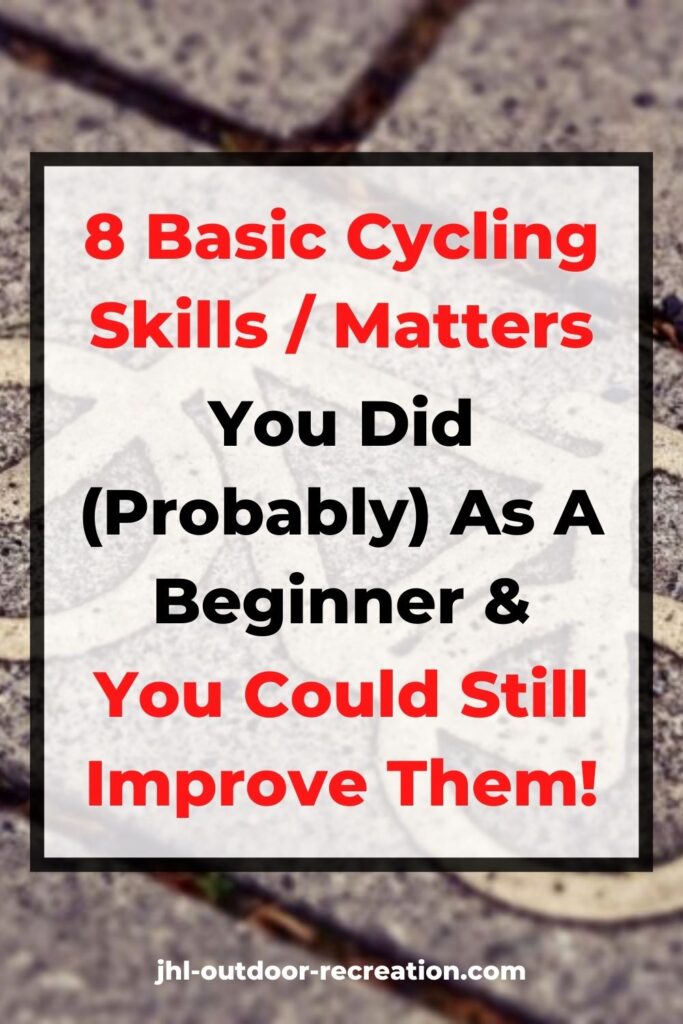Do you still remember the time when you just learned how to ride a bike? While you just got to know about cycling, were you excited and eager to explore and master basic cycling skills to ride a bike like a pro?
I do and I was.
I learned how to ride a bike when I was 5 years old. It took me for a few months to learn. I couldn’t forget THAT moment.
Once I learned how to ride a bike, I sped up my pedaling and cycled farther.
Siting on the saddle; holding both the handle bars; pedaling. What else could I do? I wanted to try things other than these and learn more about cycling.
Well, I guess you have similar experience.
Now, I’m gonna show you some of the essential yet basic cycling skills that you probably already did as a beginner but you could still improve and master them!
1. Speeding
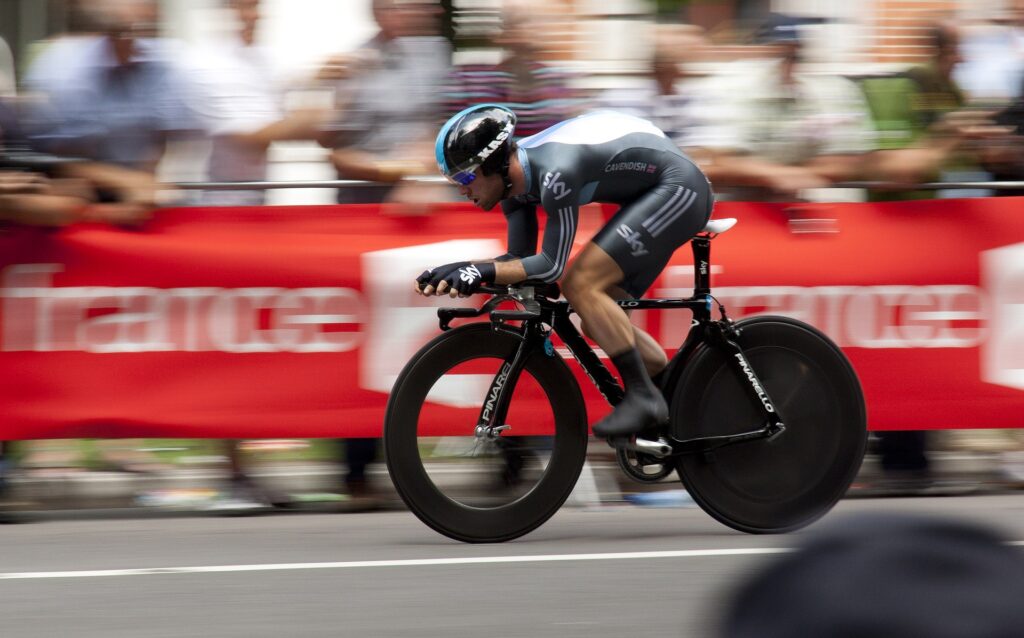
Just like a baby learned how to walk. After he was able to walk, he started to run!
When it comes to basic cycling skills, cyclists will think of SPEEDING intuitively. Well, who doesn’t like speeding? You know how great the sensation is when you overtake other cyclists or the wind hits your face and when you are speeding.
The more we ride, the better our stability is. Then, we pedal faster and harder to enjoy the excitement of speeding.
Pay attention to your cycling posture. You sit straight with straight arm when you are riding slowly. Then, when you speed up your pedaling, you will automatically lean forward and bend your arms. – You do this even without thinking!
In fact, body posture is the essence of AERODYNAMIC in cycling.
Aerodynamic cycling
There are two concerns in aerodynamic cycling: frictional drag and air-pressure drag.
The harder and faster your pedaling is, the stronger the wind you feel. The wind that you feel is FRICTIONAL DRAG. – A frictional force that drags you to pedal faster.
Another thing is your body “cuts” through the air when you are pedaling. While you are speeding, the air pressure of your front body is higher because of more air particles hit your body, whereas the air pressure of your rear body is lower because fewer air particles hit your body.
You learned physics in school. Low pressure will be “sucked” in order to neutralize the pressure. That is why a cyclist is “pulled” by this force, so called AIR-PRESSURE DRAG.
Look at the road cyclists and circuit track cyclists and observe their posture when they ride fast or sprint, even when they ride at normal speed.
The saddle is higher than the handle bar. This allows them to lean their torso very FORWARD and the direction of their torso is almost PARALLEL to the ground. Their arms bend and form an “L-shape”.
You might think this is an uncomfortable posture. But, why do they want to maintain this posture?
Because, they want to achieve AERO-POSITION by reducing their frontal areal. This minimizes both frictional drag and air-pressure drag. – More efficient and higher speed.
2. Braking
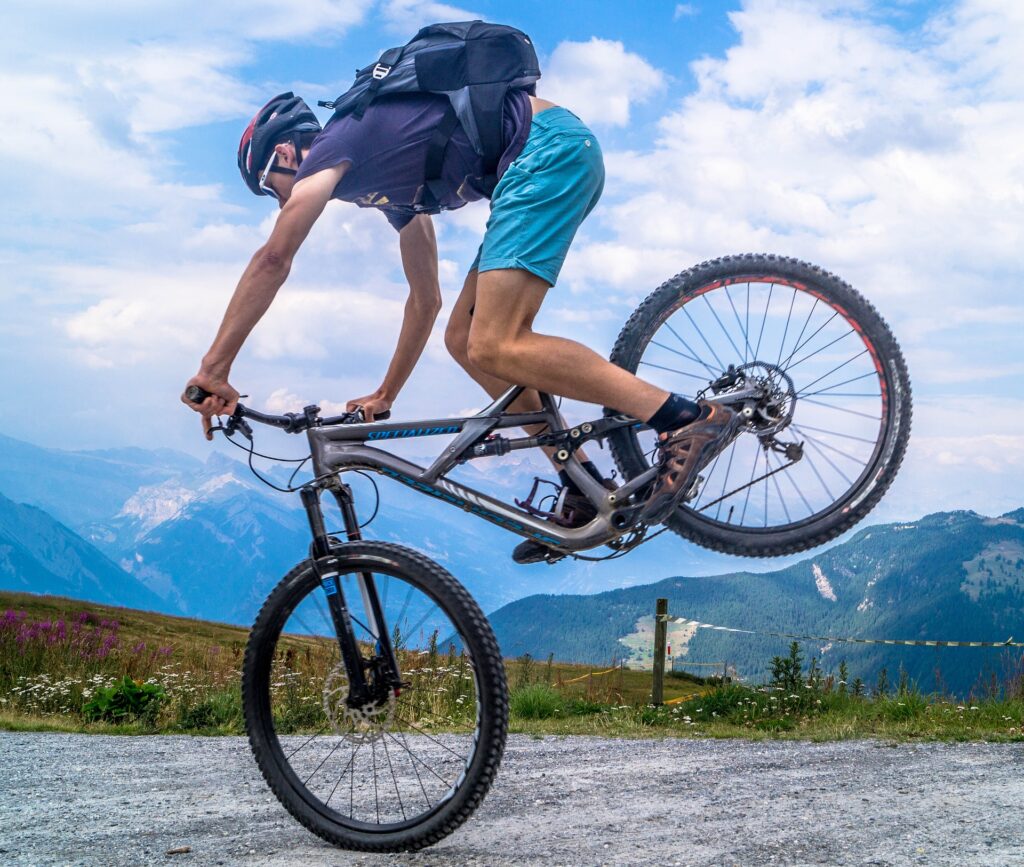
Braking is one of the basic cycling skills that you master to know for safety purpose. You know about breaking to slow down or stop even before you learn how to ride a bike. You may have emergency brakes when you spot someone rush out to the road or a speed bump, for instance.
This already implants to your brain and you react instantly before you have time to think about.
When you look at your bike, you might notice there are 2 brake levers. You might have heard of the rule: “Right for Rear and Left for Front” for brakes.
In fact, this may not be applicable to all bikes, because the order of the brakes depends on the country which the bike is produced / sold.
For example, the rule is applied in the US. But the reverse might be applied in the UK and Australia. – Which means, you need to TEST the brake by yourself, unless your bike doesn’t have two brakes.
How you should brake
Notice when you brake, your body will move forward when your bike stops. – It’s Inertia, and I’m sure you know this, too.
So, when we brake, we need to push our body back to switch the body weight backward to counter the effect of inertia.
The harder we need to brake, the more we need to push our body back. If otherwise, we might lose balance when we brake and we might fall from our bike. – Something like emergency brake in driving.
You know about front brake and rear brake. – What is the difference?
Front brake allows you to stop your bike fast, while rear break allows you to decelerate your bike before it stops.
Use rear brake in normal cases and use front brake for emergency brake. – But for emergency brake, you need to make sure you switch your weight back to avoid falling from your bike.
3. Gliding
I’m sure sometimes you pedal too much, and would like to take a break from pedaling. In this moment, you just let your bike glide so that you could chill and enjoy the scene and the wind.
Yeah. We don’t have to pedal continuously because it is quite tiring, to be honest. Sometimes, we need to take a brief pause to let our bike glide to let our leg muscles recover and to allow us to ride longer and farther.
Gliding is also necessary when a cyclist is descending from pavement or road. Instead of pedaling, cyclists control the speed by controlling the brake.
You don’t want to lose control on your bike if you keep pedaling while descending, right? Similar to braking, gliding is one of the basic cycling skills that you need to pay attention to control the speed of your bike.
4. Cornering
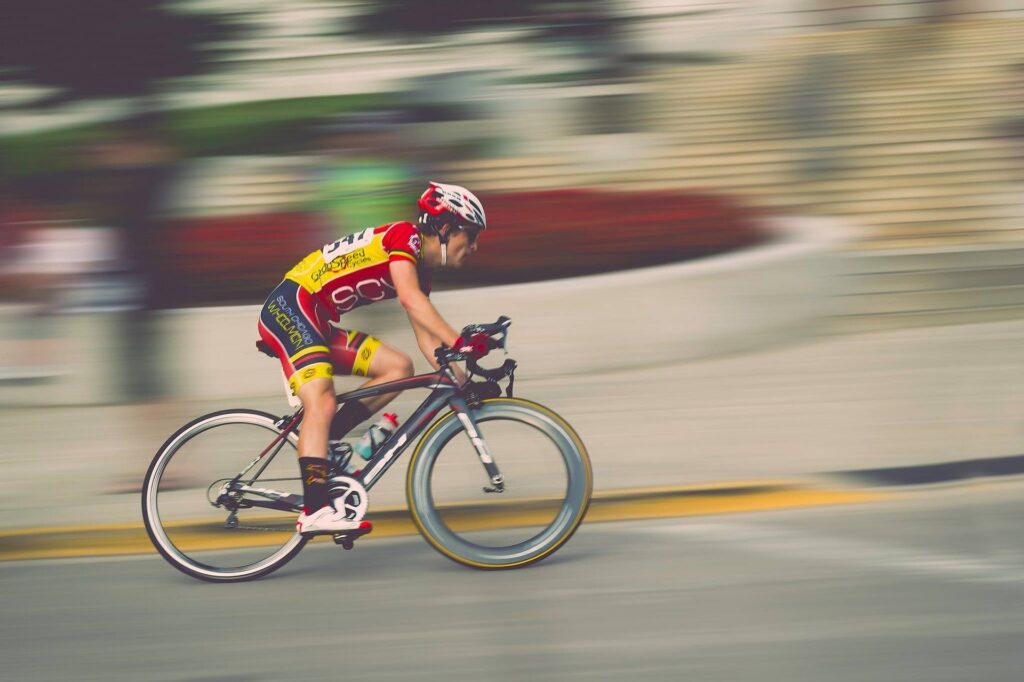
Come across to a curved road or you need to make a U-turn when you are riding a bike?
Recall what you did when you were in these situations. Did you let your bike glide and lean to the direction that you want to go?
Yeah. This is Cornering.
How it works
Let your bike glide, LOOK at the direction where you want to go, and then LEAN your bike to the side accordingly.
For example, when you want to “corner” to the right, you look at the target on your right side, and then you lean your bike to your right side. Your right leg should be at 12-o’clock position on the right pedal; your left leg should be at 6 o’clock position on the left pedal.
Leaning enables you to lower your centre of gravity so you are able to maintain your stability without falling down while you are turning.
Generally, the faster your cornering is, the more you need to lean. – Because of the lower centre of gravity required to stabilize your riding.
This makes me think of the motorbike race where the bikers lean so deeply until their knees almost touch the road while they’re changing direction. I always wondered why they won’t fall down. – Then I realize it is the same principle.
5. Changing Gears
You looked at the front and rear gears and also the shifters. As a beginner, you wouldn’t really know how this works and you probably simply pressed the shifters. Then, you heard some “clicking” sounds on the gears and noticed the chain was switched to different gears.
You were actually changing the gear. To understand how changing gear works, you need to understand the main components.
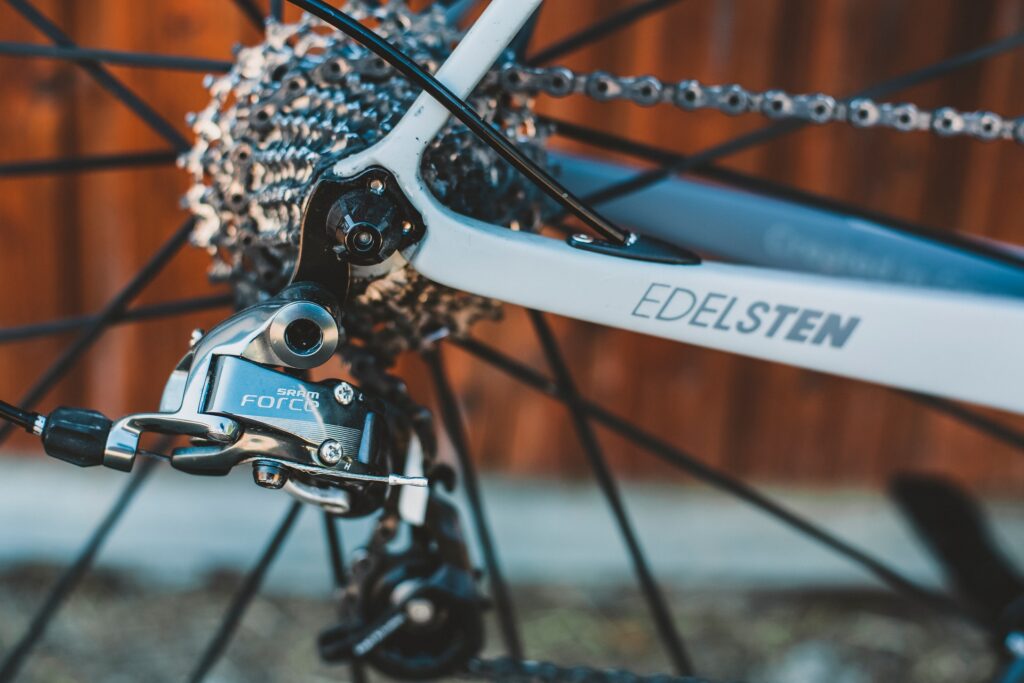
Main components
- Cassette: Collection of different-sized rear cogs
- Chainrings: Collection of different-sized front gears
- Shifters: Components, attached on the handle bars, which allow you to change gears when you press them
- Derailleur: Components installed along with the cassette and chain ring to enable changing of gears when the shifter is pressed.
For cassette, the cogs arrangement is from biggest to the smallest when it moves away from the wheel. For chainrings, however, the gear arrangement is the opposite of cassette.
Some of the bikes may only have cassette and one chainring.
How it works
If your bike has both cassette and chainrings, meaning they have both front and rear gears, then follow the rules of the brake, test and identify the front and rear gears. DON’T assume “Right for Rear and Left for Front” apply to all the bikes.
For cassette, big cog allows you to pedal easier (“easy gear”); for chainrings, however, it is the opposite.
So, what is the purpose of knowing this?
In fact, knowing what gears you need helps you pedal efficiently. It is because the strength of efficient pedaling is different when it comes to ascending, descending, and on flat ground.
When ascending, you need to adjust to an easy gear to have easier pedaling.
When descending or on a flat ground, you may need to adjust to hard gear, i.e. small rear cog / big chainring, to have powerful pedaling.
Bear in mind that you have to pedal when you are changing the gears. If otherwise, the gears won’t change or the chain may be dislocated.
But, there is no perfect gear because everybody is unique. You need to test by yourself to identify your own “best” gear.
6. Vision
You looked forward when you are pedaling to help maintain your balance and to observe the situation in front of your; you also looked at the direction that you want to go.
Yes. Pedaling is not the only thing when it comes to cycling. You wouldn’t be surprised that LOOKING is very important when you are pedaling.
Well, you’ve already “learned” this.
We look around to check if any unexpected things or people appear in front of us, so that we could act accordingly. – Just like when we want to cross a road.
We look at the direction that we want to go so that our pedaling can ALIGN with our vision to that direction.
But, what we need to do is to become consistent in maintaining our vision by looking forward and around, because we have the tendency to look down or at our bike. And we have to minimize this.
Take a look at the professional cyclists. They always look forward even when they are drinking water. They do, however, look the other way to check on their teammates or competitors or the traffic, in a split second.
7. Out-of-saddle Riding
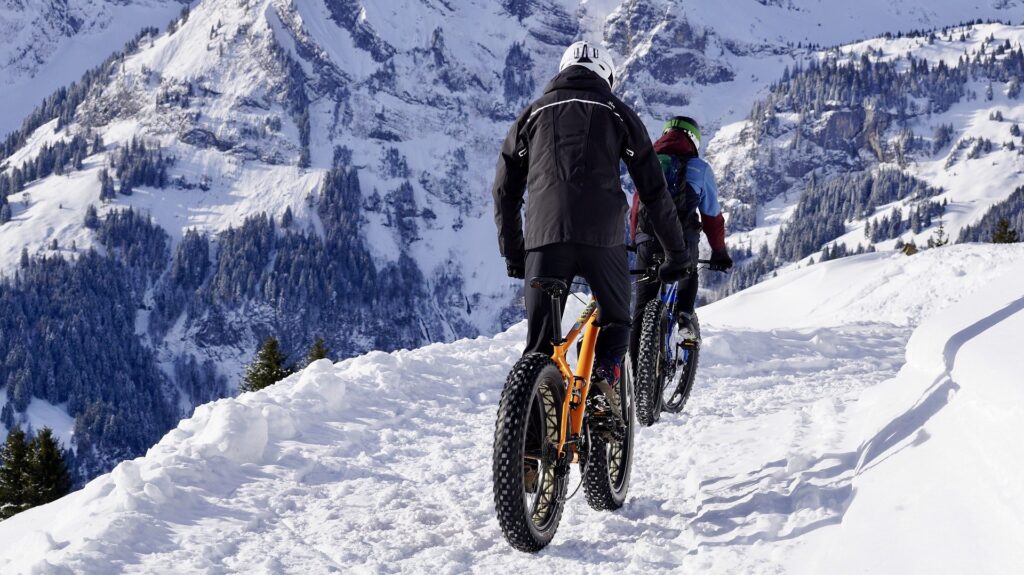
Have you ever noticed when you were chasing something or speeding up while riding, not only that you increased your cadence, but you might also kind of “stand up” from the saddle?
We might not be aware of this because we tend to do this unconsciously when we are speeding up when we are riding.
Actually, this is also a basic but essential cycling skill. – Out-of-saddle riding.
In fact, this is very crucial when it comes to ascending and sprinting. It is because out-of-saddle riding provides short yet powerful pedaling. – FYI, amongst the basic cycling skills, out-of-saddle riding is a core skill if you want to try mountain biking.
Take a look at any of the road biking competition. Observe the posture of the cyclists when they speed up to overtake their competitors, ride to the hills and sprint to the finish point.
How it works
As the name suggests, your hips are out of saddle while you are pedaling. Your body LEANS forward and this shifts your centre of gravity as well.
This allows you pedal by using your BODYWEIGHT, instead of relying on your leg muscles.
You’ll notice your pedal become much more powerful. Combined with the aero-position as mentioned above, you’ll notice your pedaling is both powerful and fast.
8. One-hand riding
I believe that you have tried this, even only once, when you are comfortable with cycling. You only place one hand on the handle bar while you are gliding or pedaling.
You might do this maybe just 2 or 3 seconds before you lose your balance. Nevertheless, you feel excited because you tried new thing, rather than the standard two-hand riding.
Why it is important
One-hand riding is not for showing off purpose. But, it is very useful when you need to do something else at the same time of riding your bike.
I’m pretty sure you saw road cyclists riding a bike along the road or waiting at a junction to turn left or right. They use their hand to provide SIGNAL to other cyclists or the road users.
Plus, one-hand riding allows cyclist to drink water while continue pedaling when it comes to long-mileage cycling. – If you were the cyclist, you don’t want to purposely stop to drink, while you can continue pedaling, right?
In fact, 2 or 3 seconds of one-hand riding is a good start. You just need to improve your stability. This can be done by practising.
Try to stretch the time a bit before your lose balance every time you practice this. I’m sure you can master it in a short period of time. – In fact, learning how to ride a bike is much more difficult than this.
Final thought on basic cycling skills
The basic cycling skills are not something new or bizarre to the beginners. In fact, you already performed most of them, if not all, without your awareness.
You do this as if they are part of your natural response. But, you just need to be aware and mindful to practice those basic cycling skills.
Eventually, this allows you to master those basic cycling skills and you’ll definitely enjoy cycling more!
Relevant posts
